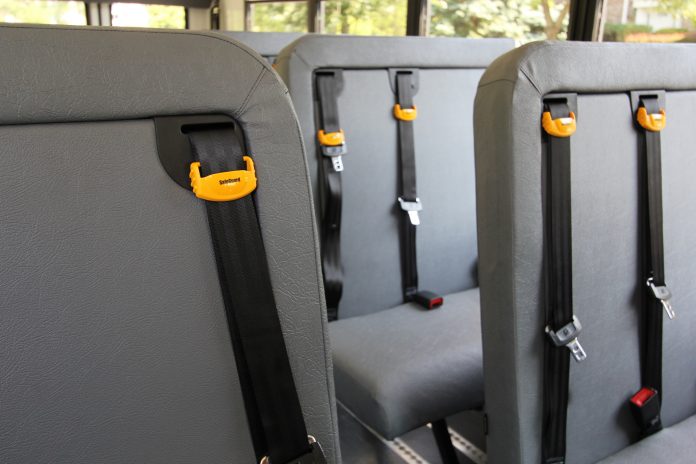I am rarely shocked anymore, but I could hardly believe my eyes when I recently viewed a video that we obtained from the Ohio State Highway Patrol. The footage displays a violent school bus crash and rollover that took place on Dec. 19 in daylight conditions.
A passenger vehicle ran a red light in Thornville, Ohio, located 37 miles west of Columbus, and struck a Northern Local School District bus headed to Sheridan High School with 25 students on board. They were propelled up and out of their seats. They slammed into bench seats, windows, each other and the bus roof, as the vehicle landed on its right side. It was disturbing to watch.
Children scream and beg for help. School bus driver Danny Hupp, 74, unbuckles his seatbelt and calls for assistance on his cell phone. His students gather themselves and evacuate through the emergency roof hatches, doors and windows. I held my breath.
Eight children were injured and transported to local hospitals. The remaining 17 students sustained bumps and bruises but were not hospitalized. No major injuries were reported.
Related: Watch: Ohio School Bus Rollover Video Reignites Latest Seatbelt Debate
Did the principle of compartmentalization reduce injuries and eliminate fatalities? Would lap/shoulder seatbelts have further helped to reduce injuries in this scenario?
Several national media outlets aired clips of the video, and the coverage has clearly reignited the “Great Seat Belt Debate.” An NBC Today Show host said that seatbelts on school buses seem like a “no brainer.” But the discussion about tight school district budgets also came up, as the estimated cost of implementing lap/shoulder belts ranges from $7,000 to $10,000 per bus.
Meanwhile, two districts in the Cleveland area have installed school bus seatbelts. Avon Lake City Schools is testing the seatbelts on two buses, with mixed results. Get- ting students to wear the occupant restraints has been one of the issues. The suburban district, located on the shores of Lake Eerie, has employed additional monitors to ensure compliance. Other districts, like Helena Public Schools in Montana, have found success with implementing and enforcing mandatory student usage policies.
The other district to implement seatbelts is Beachwood City Schools, where elementary school students last year successfully petitioned the school board to make available the necessary funds to equip their school buses. The district currently has seatbelts on two of its highway route and field trip buses. Several other local city councils also recently pledged support for pilot programs.
We kicked off last year’s inaugural STN EXPO Indy conference with a school bus crash test demonstration hosted by SafeGuard and IMMI at the Center for Advanced Product Evaluation facility. The event sought to simulate a rollover crash by launching the bus off of a ramp to see what would happen to belted and unbelted occupants. Visit stnonline.com/tag/STNIndy19 to view the video. Another crash test is planned for STN EXPO Indy attendees in June.
The National Transportation Safety Board (NTSB) also determined that compartmentalization is “incomplete” and “does not protect passengers during lateral impacts with vehicles of large mass, in rollovers and from ejection.” A SafeGuard crash test performed in August 2017 depicted a T-bone crash by a work truck, and one of the unbelted dummies was fully ejected out of the school bus. The NTSB stated lap/shoulder seatbelts would protect passengers in most crash scenarios.
The federal School Bus Safety Act, co-sponsored by Sen. Tammy Duckworth and Rep. Steve Cohen, is calling for three-point seatbelts on school buses, in addition to other safety enhancements recommended by the NTSB. But the legislation has failed to move out of committee, where it has sat since last July.
Today’s modern school buses have safety equipment options like passive and active stability control technology, to help drivers avoid losing control. It was unclear at this writing if the 2020 IC Bus that was involved in the Ohio crash had stability controls installed, and if the technology could have made a difference in the outcome of the crash.
The National Highway Traffic Safety Administration finalized a rule requiring ESC as a standard feature on Class 7 and 8 truck tractors as well as motor coaches, but it exempted school buses. However, school bus OEMs Blue Bird, IC Bus and Thomas Built Buses and their respective technology partners, Bendix Commercial Vehicle Safety Systems and Meritor, proactively made the safety feature standard equipment on Type C models.
According to Jeff Cassell, founder and president of the School Safety Company, nothing seems impossible with today’s technology. But ultimately, safety comes down to driver training, defensive driving techniques and best practices when operating a school bus.
I recommend looking at all of the available data when investing in any new safety technology and training tools. Research and measure the best options for your operation. Your students and bus drivers will be glad you did.
Editor’s Note: As reprinted from the March issue from School Transportation News.
















